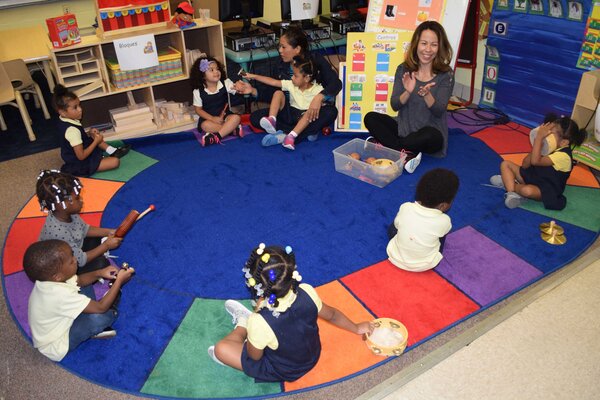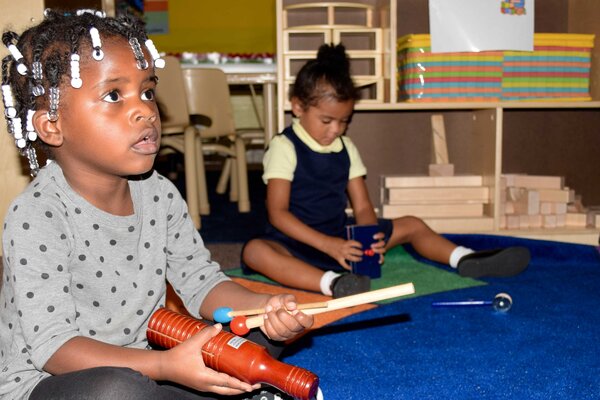
Natalie Gross/The Hechinger Project | Caption
To help low-income kids, more schools try dual-language programs
by Natalie Gross / The Christian Science Monitor
With eye toward equity, schools in low-income, black neighborhoods try controversial approach. Part 1 of 2.
Washington—In Ivonne
Kendrick’s classroom at Houston Elementary School, 3-year-olds sit
cross-legged in a circle, listening to their teacher sing about the fall
season.
“Llega el otoño tras el verano,” (Autumn comes after summer), they repeat after her in Spanish. One month into the school’s new dual-language program, their accents are unmistakably American. But they know how to ask for a manzana, or apple, at snack time and recognize that when Ms. Kendrick says “fila,” that’s their cue to form a line. The next day, the students will continue their lessons in English, alternating between the two languages throughout the week.
Houston is a low-performing school in the Deanwood neighborhood of Washington. Its dual-language program is the first to be offered in the area east of the Anacostia River, home to the city’s two poorest wards. The school’s student body is almost entirely African-American.
“Llega el otoño tras el verano,” (Autumn comes after summer), they repeat after her in Spanish. One month into the school’s new dual-language program, their accents are unmistakably American. But they know how to ask for a manzana, or apple, at snack time and recognize that when Ms. Kendrick says “fila,” that’s their cue to form a line. The next day, the students will continue their lessons in English, alternating between the two languages throughout the week.
Houston is a low-performing school in the Deanwood neighborhood of Washington. Its dual-language program is the first to be offered in the area east of the Anacostia River, home to the city’s two poorest wards. The school’s student body is almost entirely African-American.
With bilingualism linked to enhanced academic and social skills, educators say dual-language programs can be used to narrow the achievement gap and equip underserved students for a future in a competitive workforce. Houston is one of a growing number of schools targeting bilingual instruction to black children in low-income areas. Its Spanish-English program opened at the preschool level this school year.
Jimell Sanders, a Houston parent and co-founder of the nonprofit D.C. Language Immersion Project, said there is growing demand for dual-language programs in D.C., with as many as five kids on the waiting list per available slot. And it isn’t just parents in the wealthier Northwest neighborhoods – where a high concentration of such programs are located – who want in.
Ms. Sanders, who is African-American, first presented the idea for a dual-language program at Houston to the District of Columbia Public Schools in 2014. She said the lack of such programs in predominantly black, low-income neighborhoods east of the river “clearly is an equity issue that has to be addressed.”
The United States Department of Education defines dual-language programs as “a type of bilingual education program in which students are taught literacy and academic content in English and a partner language,” often Spanish or Chinese. There are at least 2,000 of these programs in US schools, experts say — up from about 260 in 2000 . On Nov. 8, California became the latest state to embrace dual-language learning , voting to undo the provisions of a 1998 law that had mandated that learning be “overwhelmingly in English.” The growth has largely been driven by advocacy from white, affluent families, as well as by districts responding to an influx of immigrant students.
Meanwhile, schools in metro areas like Miami and Philadelphia and smaller cities like Urbana, Ill., among others, have started programs in predominantly black, low-income neighborhoods to ensure students from all backgrounds have the opportunity to become bilingual.
This approach can be controversial, as Joe Wiemelt, who directs bilingual and multicultural programs in central Illinois’ Urbana School District 116, witnessed firsthand four years ago. When a proposal to expand the district’s bilingual offerings to a school that was 85 percent African-American was presented to the school board, it sparked debates in the community about issues of race. Many wondered whether these students were “the right fit for dual-language,” Mr. Wiemelt says. The motion to start a dual-language program at the school eventually passed by a narrow 4-to-3 vote.
“One of the arguments levied against African-American children, especially in the poor areas where the dual-language programs are springing up, is that, ‘Well, these kids don’t speak standard English anyway, and we need to work on their standard English,’ ” says Howard Smith, a professor of bicultural-bilingual studies at the University of Texas, San Antonio.
It’s a common argument, even among educators. Katarina Brito, a bilingual program developer for D.C. Public Schools, said some would rather see schools ensuring students are proficient in reading and writing in English before teaching those skills in another language.
But research shows dual-language programs may actually enhance students’ learning in English. A multiyear study of students enrolled in two-way dual-language programs in North Carolina between 2007 and 2010, found that low-income black children in these programs scored higher in reading and math than their classmates of the same race and socioeconomic background who were being taught in one language. By fifth grade, these students were reading as well as their monolingual peers in the grade above them, according to the study conducted by George Mason University researchers.
Challenging approach
Based on this research, Ms. Brito sees dual-language programs as a viable intervention for students who are struggling in school – not just as enrichment for children who are already performing at grade level. But she acknowledges there are challenges.“When you’re talking to a principal who is looking at the school full of kids who are struggling academically, it’s hard to say, ‘And now bring in this really complex, hard-to-manage program with very limited resources and convince all your parents,’ ” she said.
Houston Elementary fits the profile of a struggling school: Just 12 percent of students in third, fourth, and fifth grade last year met expectations on the districtwide standardized math test, and 6 percent met expectations in English language arts.
Houston Principal Rembert Seaward hopes the new preschool program will help lay the foundation for future success. He explained that many of the students face stressful situations at home, which can affect their performance at school. (A recent analysis of public safety in D.C. found that while the city’s violent crime rate has gone down, Deanwood and surrounding neighborhoods have actually experienced an uptick since 2000.)
Nelson Flores, an assistant professor of educational linguistics at the University of Pennsylvania, points out that dual-language programs are not a panacea.
Challenges like staff turnover and low levels of parent engagement, typical in high-poverty schools, can be exacerbated in a dual-language setting, when teachers must have bilingual skills and parents, often working multiple jobs, are not able to help their kids with schoolwork — especially in a language they don’t understand.
In order for dual-language programs to be successful in these settings, schools have to address broader issues such as teacher quality and wraparound services for families in need, Flores said.
At the same time, he believes dual-language programs in majority-black classrooms can embrace students’ cultural and linguistic backgrounds, engaging them in ways traditional schools haven’t.
For example, at the brand new Independence Charter School West in Philadelphia, which is 85 to 90 percent black, Flores has been working with staff to ensure that the experiences of black native Spanish speakers are represented throughout the dual-language curriculum.
These programs can also do a better job of affirming variations of English “than a monolingual program that hasn’t really thought about the value of linguistic diversity,” Flores says.
Way to attract more students?
Sanders and her colleagues at the D.C. Language Immersion Project hope Houston’s new program will make the campus more attractive to families considering their elementary school options through D.C.’s school choice program.“In the past, anybody socioeconomically advantaged who lived in the Deanwood community would have crossed Houston off their list,” said Vanessa Bertelli, Sanders’s co-founder and executive director of the organization.
And, long-term, the advocates hope that students will see more opportunities for themselves as they enter a workforce in which the demand for multilingual skills is growing.
D.C. has already “reached a point where the bank tellers need to be able to speak Spanish,” Bertelli says. “The health care, the social services people need to be able to speak Spanish.”
For Sanders, more dual-language programs at schools like Houston are good news for kids like her 3-year-old daughter Layla, who is already singing Spanish songs from Kendrick’s classroom at home.
She wants Layla to be able to be “at the table” someday, leading discussions in the workforce and in a global society – conversations, Sanders says, that won’t always happen in English.
This story was produced by The Hechinger Report , a nonprofit, independent news organization focused on inequality and innovation in education. Read more about early education .

Very important article.
ReplyDeleteThis comment has been removed by a blog administrator.
ReplyDelete